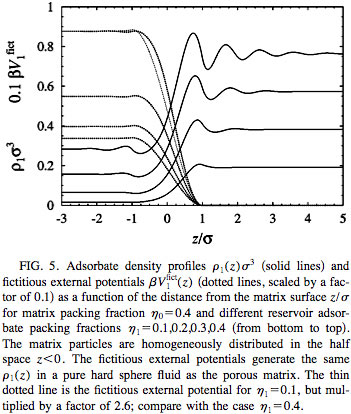| 37. |
Hard sphere fluids at surfaces of porous media M. Schmidt, Phys. Rev. E 68, 021106 (2003). Locate in [bare] [illustrated] list. Get [full paper] as pdf. Extract. An adsorbate fluid of hard spheres is brought into contact with a semi-infinite porous matrix. Comparison of results from a recent density-functional approach to those of our computer simulations yields good agreement for the adsorbate density profile across the matrix surface. [more]  Read the [full paper] as pdf. |
Fluid interfaces
Colloid-polymer mixtures display fluid-fluid interfaces [21] [44], relevant for laser-induced condensation [35], capillary condensation [43] and evaporation [48], immersion in porous media [41], the appearance of the floating liquid phase [52], the competition between sedimentation and phase coexistence [51], tension at a substrate [45], the experimental observation of thermal capillary waves [47], and the contact angle of the liquid-gas interface and a wall [50]. In colloidal rod-sphere mixtures fluid-fluid interfaces were investigated with theory [30] and simulation [42]. Hard sphere fluids were considered at surfaces of porous media [37], in random fiber networks [39], and in one dimensional cases [46].Hard spheres
The hard sphere system freezes between [2] and [3], and in ~[23] dimensions (tags as contents!), as well as on stripe-patterned substrates [26]. Deep relations to dimensional crossover exist [5] [6]. Hard spheres were immersed in emulsions [9], confined to a flexible container [18], exposed to surfaces of other quenched spheres [37] and of random fiber networks [39], and subject to gravity [51]. Recently, the Rosenfeld functional [5] [6] was generalized to non-additive mixtures [53].[more]